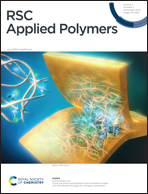Macroporous hydrogels for soil water retention in arid and semi-arid regions†
Abstract
High water loss in arid and semi-arid regions makes it difficult for plants and microorganisms to thrive, which then prohibits generating organic matter in the soil. We hypothesize that the implementation of macroporous hydrogels in soil can enhance water retention and irrigation efficiency through improved uptake and release kinetics compared to bulk hydrogels. Water is mainly held in the cavities of the macroporous morphology making it more accessible to plants. The improved water kinetics can lead to better crop yield and improved soil health when water scarcity is a significant issue. In this work, macroporous acrylate-based hydrogels are fabricated using the high internal phase emulsion (HIPE) templating method. The solid hydrogel is incorporated into the soil as a powder to measure its influence over soil-water kinetics. The resulting hydrogels have an average porosity of >85% and an average void size of <3 μm. The macroporous hydrogel shows a ∼700 wt% increase in water kinetics in less than 1 minute of water absorption and a water release rate 3.5 times higher than the bulk hydrogel. The addition of the porous hydrogel to sandy and sandy loam soil enhances water retention but lowers plant available water due to the higher water potentials.



 Please wait while we load your content...
Please wait while we load your content...